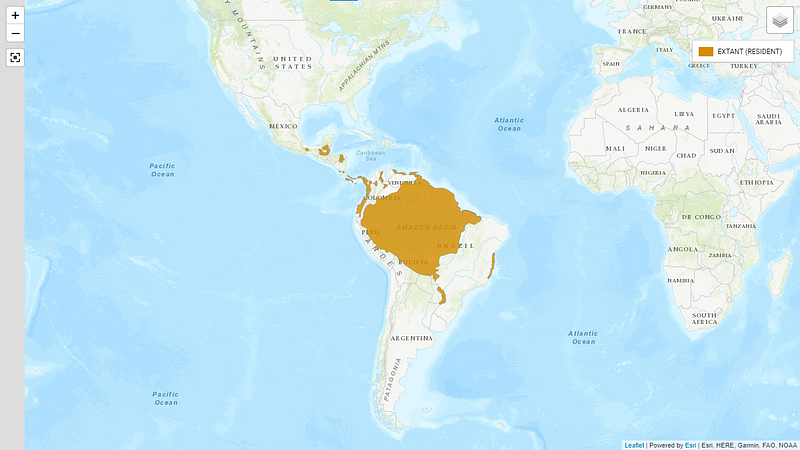The Majestic Harpy Eagle: Guardian of the Tropical Canopy
Written on
Chapter 1: The Enigmatic Encounter
Imagine yourself on a vacation in a vibrant tropical rainforest in South America. One morning, while taking a stroll before breakfast, you hear an unexpected commotion high in the trees, followed by the appearance of a colossal shadow.
Looking up, you are greeted by the sight of an incredible bird—the harpy eagle—observing her domain from above. This marks just the beginning of your introduction to one of nature's most awe-inspiring and mysterious birds.
Also referred to as the “Queen of the Forests,” this formidable raptor is both revered and feared due to her impressive stature and significant role within tropical ecosystems. The harpy eagle (Harpia harpyja) stands as one of the world's largest raptors and is the largest within the Amazon rainforest.
With an impressive wingspan that can extend up to 2.5 meters (almost 100 inches), these eagles soar through the South and Central American skies. Females can weigh as much as 9 kg (20 lb) and are notably larger than their male counterparts. Their talons, which are larger than those of a black bear, are some of nature's most effective hunting tools.
Fun Facts About Harpy Eagles: 1. Contrary to popular belief, harpy eagles do not hunt children. This myth likely arose because they often prey on larger monkeys, such as spider monkeys, which can appear similar to small children from a distance. 2. Their powerful talons enable them to lift animals weighing up to 30 pounds and carry them through the air. 3. These eagles are monogamous; pairs mate for life and share responsibilities in raising their young, which occurs every two years.
Where Do They Reside? This extraordinary predator thrives in tropical forests from Mexico to Brazil, favoring primary forests in secluded regions where prey is plentiful and nesting opportunities abound.

Current Distribution of the Harpy Eagle BirdLife International and Handbook of the Birds of the World 2021. The IUCN Red List of Threatened Species. Version 2023–1
Chapter 2: Masterful Predator in Action
Despite their imposing presence, harpy eagles demonstrate exceptional hunting skills and adaptability. They primarily feast on tree-dwelling mammals like monkeys, sloths, and coatis, but they also target larger birds and reptiles. Utilizing their keen eyesight and formidable talons, they capture prey either mid-flight or from the canopy's heights, often transporting their catch to nests in towering trees to share with their mates and young.
Observing a harpy eagle in flight is akin to witnessing a work of art. These raptors glide gracefully through the branches, employing their sharp vision and remarkable hearing to locate prey with precision.
The first video, "Harpia Harpyja: The Majestic Amazonian Harpy Eagle," showcases the beauty and behavior of this incredible bird in its natural habitat.
What Role Do They Play in the Ecosystem? As apex predators, harpy eagles are crucial for regulating populations of mammals and birds. Their significant appetite helps maintain balance within forest ecosystems. The presence of these eagles is a strong indicator of the biodiversity and health of tropical forests; their sightings signal that the ecosystem is functioning properly.
Conservation Challenges Ahead Despite being iconic figures in tropical forests, harpy eagles confront numerous threats, including habitat destruction, deforestation, illegal hunting, and the wildlife trade involving their feathers and body parts. It is vital to protect their habitats and implement conservation strategies to ensure the survival of this remarkable species.
How Can We Help? Harpy eagles symbolize the magnificence and beauty of tropical forests while also playing a vital role in their health and balance. Supporting conservation initiatives, promoting environmental education, and advocating for protective policies can help secure a brighter future for the harpy eagle and the myriad species sharing their environment.
“Only if we understand, will we care. Only if we care, will we help. Only if we help shall all be saved.” — Jane Goodall
Chapter 3: Discover More Forest Inhabitants
The second video, "Majestic Harpy Eagle: Queen of the Forest Canopy," illustrates the grandeur and ecological importance of this bird of prey.
Read about other forest creatures:
Under the Moonlight: Exploring the Fascinating World of Bats Picture this… it’s a warm summer night, you’re sitting in your backyard, and the moon is shining high when suddenly, a…
No Opposable Thumbs Found, However… Here are 6 curious facts about spider monkeys.